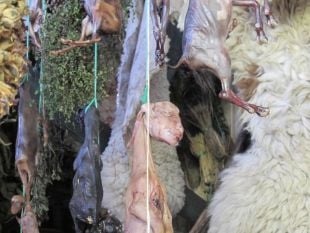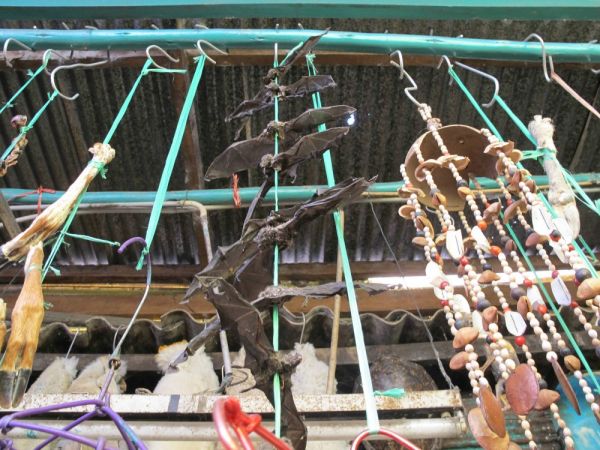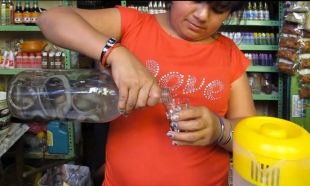High Costs and a Shortage of Doctors Keep Traditional Healers in Business

Thirsty? Photo credit: Manuel Vigo
A couple of flies circle crazily around a half-dozen dried-out bat carcasses hanging from strings, their bodies contorted into grim positions suggesting rigor mortis.
“They’re used for treating epilepsy,” the shopkeeper tells me assuringly. Her name is Joana, a lively vendor in a downtown Lima, a stone’s throw away from the La Parada wholesale market. “You grab the bats, boil them and make a tea.”
Joana’s stand is a colorful riot of plants, oils, soaps and extracts. Bottles containing different types of liquids are arranged into neat rows on uneven shelves. Dried animal parts hang from the ceiling, some of them nearly unidentifiable. To some, this might look like the hoarded collection of a madwoman. To others, it’s medicine.

To some, Joana’s merchandise is grotesque. To others, it’s medicine. Photo credit: Manuel Vigo
“Everything is fresh,” Joana says, inhaling deeply, filling her lungs with the rich, earthy scent that permeates the air. It’s an overwhelming smell, but not unpleasant, with crisp overtones of flowers. Her stand features a wide array of herbal remedies, aimed at curing everything from the common cold to depression. Although once illegal, traditional medicine is still widely practiced in the country, and the government-run National Institute of Traditional Medicine is in charge of not only regulating, but preserving these practices.
Many of the goods in Joana’s shop are the remnants of medicinal techniques that originated in the highlands centuries ago and arrived in Lima during the urban migration that has transformed the city over the past fifty years. People who grew up in remote areas of the country, far from any modern health clinic, relied on these remedies to cure their ills. Today in Lima, many still do.
This isn’t just out of nostalgia. Even in modern Peru, modern medical care is unaffordable for many. The country is also struggling with a shortage of doctors — Peru has only about half as many as it needs. Data from the World Bank show that there is fewer than one physician for every 1,000 Peruvians, compared to countries like Spain and Japan, which have four and two physicians for every thousand citizens respectively.

Cures include everything from snake-infused booze to bat-carcass tea. Photo credit: Manuel Vigo
But for some, it is indeed a personal preference for informal medical care that sends them to vendors like Joana. Sara (not her real name) tells me that her husband sought out traditional medicine after an unsuccessful treatment to cure his inflamed prostate.
“He went to a doctor and they gave him pills, but they were making him feel sick,” she says, “so he stopped taking them.”
“Out of chance, one day he was at a market and saw a medicinal stand, and told the person what the problem was. They gave him some herbs and tea, and it started to work for him.”
Although traditional medicine is a regulated industry in Peru, the laws are rarely enforced. Natural plants and extracts often share shelf space with other products that seem far more exotic. Ingredients for “magic” potions are sourced illegally, and the entire industry exists in a legal gray area, like much of the informal economy in this country.
Joana, for instance, suddenly finds her inner introvert when I ask her where she gets her ingredients, which include dried goat legs and spiders. “From all over,” she says coyly, refusing to elaborate.

Joana pours a shot of an elixir said to cure everything from sprains to cramps. Photo credit: Manuel vigo
Among the various bottles in her shop, one stands out: An oversized glass jar filled with snakes floating in a clear liquid, like Hollywood’s notion of a witch doctor’s cure.
This “snake alcohol” can cure pretty much anything, Joana tells me. For only one sol (about 40 cents USD), patients are served a shot glass of the powerful snake potion, which, in addition to serpents, is made from sugar-cane alcohol. This shot, I hear, does not go down easily. But the health effects are worth it, Joana promises. “It’s good for cramps, colds, sprains, dislocations…” The list goes on.
A friend who’s accompanying me volunteers to try it, and Joana prepares a special batch, adding a bit of honey to help the medicine go down. My friend throws back the shot, fighting his gag reflex. Joana’s son sits next to her, looking amused. I imagine he’s probably been given some of the remedies for sale here himself from time to time.
“There you go — no more cold, cramps,” Joana says, smiling at my friend, his mouth still tightened into a grimace. “No more fear.”









